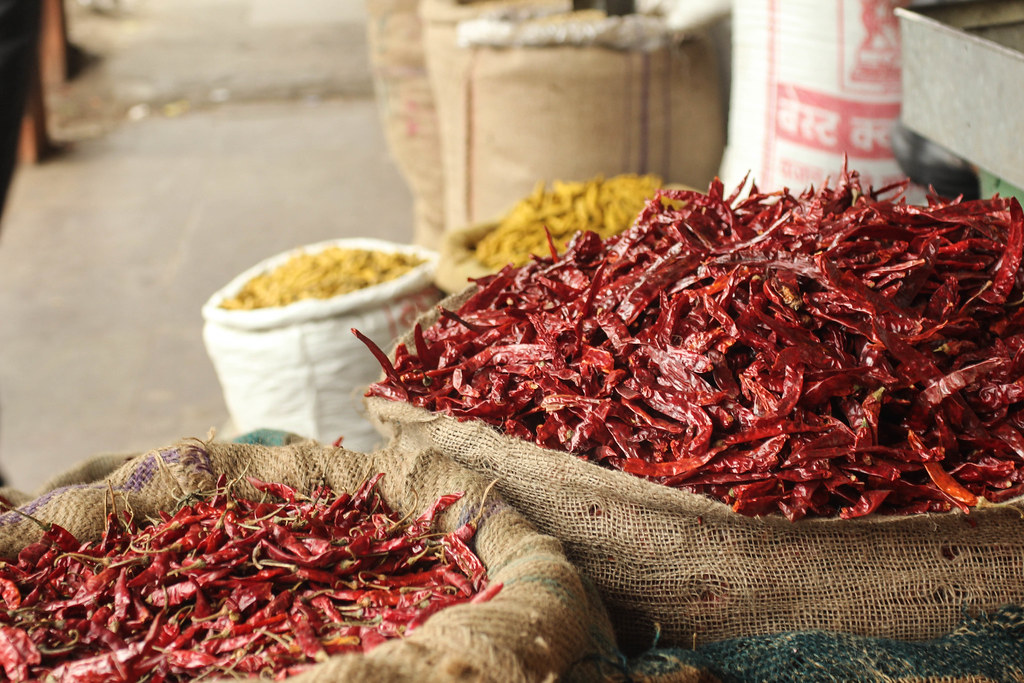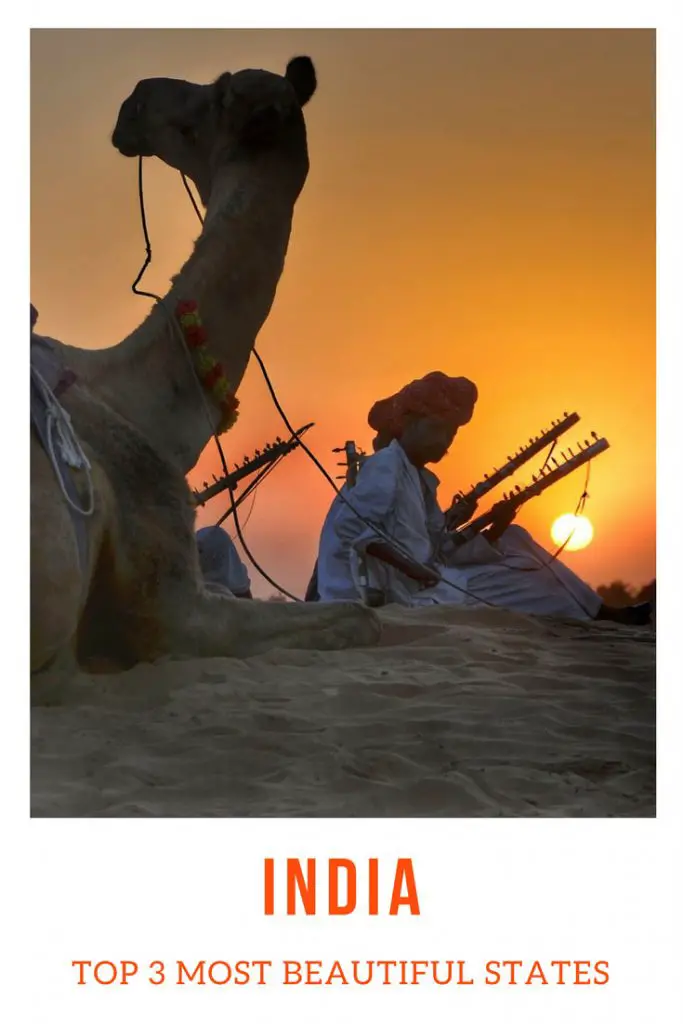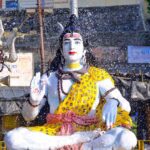
If traveling for the entire span of your lifetime through India, it still wouldn’t be enough to see it all. The country is so big, with each region having its own culture and traditions that have been kept through the years and influences by the other nations that have passed through. Delhi is different than Mumbai which is different than Calcutta, which is different than Kerala. In fact, each state is different from each other and this is what makes each trip to India so unique and fantastic!
Trying to find the most beautiful states to visit in India is definitely a challenge, especially that each of them make major efforts to show the world what makes them special. And when it comes to who has the most influence, I can mention Kerala Tourism and their yearly campaigns to discover the state. So, which is the most beautiful state in India?
The most beautiful Indian states:
Rajasthan

Even if it covers a large area in the desert, Rajasthan is probably one of the most colourful states of India. But not only, the Murghal architecture, the intricate carvings that cover temples and the majestic forts overlooking their cities, make Rajasthan one of the most popular places to visit in India. No wonder that Rajasthan has been included in a circuit called “The Golden Triangle”. Whilst the triangle represents the geographical position of the three major cities connected to it, Delhi, Agra and Jaipur, you might wonder what the gold might stand for. Well, the gold is a metaphoric representation of the historical, cultural, architectural and religious wealth that the region has to offer. Rajasthan is without a doubt, India’s most beautiful state.
Every major city in Rajasthan seems to have its own colour: Jaipur is pink, Udaipur is white, Jodhpur is blue, Jaisalmer is golden. Each of them however has its own traditions and culture and they offer different unique experiences.
Unique experiences in Rajasthan
Bikaner and the desert camel safari

The majority of the tourists who visit Rajasthan and decide on a desert safari do it in Jaisalmer, because of the proximity of the sand dunes to the city. However, if you want to enjoy the desert all to yourself, without any other souls around, try this experience in Bikaner.
The desert around Bikaner is grainer but smoother for the camel to walk on. If you have never been on a camel before, just remember that riding on it it’s not as easy as it looks, especially on uneven terrain.
Once arrived in the desert, the locals will prepare an open fire cooked meal and, if you are lucky, they will engage afterwards in a traditional sing and dance performance as well. I was lucky to be there on Christmas Eve and they even brought out cake! How did they carry it all the way into the wilderness? On a camel!
The sunsets are special seen from the desert. The sun goes down, in between the dunes, setting the sky behind on fire: red, yellow, orange, and a mix of them paint the entire horizon, until the moon and the stars rise, and the day turns into night.
Udaipur and the miniature painting

I honestly didn’t expect for Udaipur to be such an artistic city. Situated on the shore of Pichola Lake, Udaipur greets its tourists with beautiful white palaces along the water, among which you will find plenty of painting and crafts shops. The local artistic speciality is the miniature painting, and artists all over the city show their skills by painting intricate designs on tiny pieces of paper, on silk, even on your nails! The most common motifs seem to be the local fauna: elephants, camels and horses.
If this type of art interests you, there are plenty of artists who open their studios to tourists and offer cheap lessons of introduction to miniature painting.
Jaisalmer and the local life

Probably one of my most vivid memories of India comes from Jaisalmer. After strolling around the narrow streets of the fort, which is the only one in Rajasthan still inhabited, observing the local life and browsing through the bazaar, our group met for dinner at one of the restaurants just outside the city gates, Saffron. We climbed up to the rooftop where a long table was prepared for us. As the sun started to set and cover the city in that golden shade that it is famous for, the lights started to turn on, one by one, house after house, until the entire fort was lit up when the darkness took over completely. Besides our table, three men were singing at traditional Rajasthani instruments. And at that restaurant I had the best meal in India, to the day! With the most fantastic view over the fort on one side and the lower city on the other.
Jodhpur and the zipline over the fort

I never thought of India as an extreme sports destination, but one of the main attractions of Jodhpur proved me different. The Flying Fox zipline stretches on a total length of 300 meters, on a circuit that takes around 1,5 hours to complete. The longest line flies over two lakes and lands on top of a fortified tower 30 meters above ground. There are 6 lines in total which offer spectacular views of the Mehrangarh Fort and the blue city of Jodhpur.
The experience pumps your heart with adrenaline and excitement. I am afraid of heights but still enjoyed it fully, knowing I was in the safe hands of the instructors.
Jaipur and the Raj Mandir cinema
You can’t visit India and not experience a little bit of the Bollywood movie culture! One of the best places to go watch a Bollywood movie is actually in Jaipur, at the Raj Mandir cinema.
Before you step into the cinema, arrive half an hour early and buy a terracotta mug of sweet lassi, from one of the stalls across the street. It will probably be the best lassi you will have in India! The small shops are usually only frequented by locals, so as a tourist, prepare to see some smiles and giggles when you try to copy them and smash the cup at the end – as the locals do.
The Raj Mandir cinema is an experience rather than just a movie theatre. As you step inside the building you will notice large chandeliers decorating the lobby and wooden tiles with glass inlay dressing up the walls.
Inside the actual cinema hall, the screen is covered with a large red velvet curtain that lifts at the beginning of the movie. Under each seat there are air vents through which floral scents are released into the hall over the duration of the movie.
Assam

Home of the one-horned rhinos and famous in the entire world for its tea production, Assam is a beautiful state in India full of green landscapes, at the foothills of the Himalaya mountains. There are plenty of things to do and see in Assam, starting with temples and archaeological sites, the distinctive culture with exotic dance forms and flavoursome cuisine, the friendly locals, the rice fields and the tea plantations.
When you think about India and then travel to Assam, your impression of the busy, noisy, dirty streets of Delhi, which you might associate with the entire country, disappear into the crisp, fresh mountain air. Assam is not touristy at all, due to the Restricted Area Permit abolished in the 90s, so expect to discover here the traditional culture, unaltered.
What to experience in Assam:
Visit Kaziraga National Park

Rather than a National Park, Kaziraga is considered more of a sanctuary for endangered animals, with focused continuous wildlife conservation efforts. Among the diverse fauna living in Kaziraga National Park, there are 15 mammalian species which threatened to become extinct in the near future. Same as Kruger National Park in South Africa has its own “five”, on Kaziraga’s “big five” list you will find the one-horned rhino, the Asian Elephant, the Royal Bengal Tiger, the wild water buffalo and the swamp deer.
In fact, 57% of the entire world population of wild water buffalo lives in this National Park. Another curious novelty is that here you will find one of the few wild breeding areas outside Africa for big cats, such as leopards and tigers.
Even the rivers of Kaziraga National Park are home of endangered species, like the Ganges Dolphin.
If you want to visit Kaziraga National Park keep in mind that it is closed during the Monsoon season (May to end of October). Guided visits are a must, as hiking on your own is prohibited. Please do not choose an elephant guided tour, go to the jeep one instead. Read the reasons why here.
Explore the Tea Plantations in Assam

Unless you have never drank tea, it’s impossible to not have heard of or tasted the Assam tea. Visiting a plantation and learning about the process of cultivation and production of tea is a unique experience.
Did you know that the tea plantation in Assam have their own time zone? During the British occupation days, to maximise the daylight in the area, the time zone has been set to IST+1. This system has improved the productivity of the workers from the tea plantations.
Every year, Assam region produces over 680 million kilos of tea. Due to the cold, arid winters and the hot, humid summers, the tea leaves can be harvested twice a year.
A hiker’s paradise
With a privileges location, at the foothills of Himalaya mountains, the highest in the world, there are plenty of spectacular hikes around Assam. From flat trails through the forests, to moderate treks through lush valleys, to rock climbing on via ferratas and rappelling into canyons, Assam is the perfect option for every type of outdoor activities lover.
One of the most spectacular hikes in Assam is to the top of Nohkalikai Falls, a 340-meter-high waterfall, the 4th largest in the world. The path to the top is sinuous and not very well maintained, and it’s advisable to hire one of the locals to guide you to the top. On the way up you will pass by gorges created over the years by the heavy rains during the monsoon seasons. The colour of the water inside them and at the bottom of the waterfall is a stunning emerald shade of green.
Enjoy a Brahmaputra Cruise

If you want to travel slow and take time to admire the beauty of Assam, you should opt for a river cruise of the Brahmaputra river (The Son of Brahma). Being the only “male” river of India, it runs 900 miles down through the country, conjoining the Ganges to form the Brahmaputra-Ganges Delta. It originates in Tibet and on its way towards the Bay of Bengal it crosses China, Bangladesh and finally, India.
It is possible to reach Kaziraga National Park by boat, cruising the Brahmaputra river. Not only though, as during a seven days cruise for example you can also explore small villages and tribes ashore, visit temples, enjoy traditional dance performances on board, or stop at plantations to taste the Assam tea. This is considered to be one of the best river cruises in the world.
Try the traditional Assamese food

Each state in India has its own traditional cooking methods, and Assam is no different. The geographical location makes Assam a great place to grow leafy vegetables like spinach, mint, coriander, patchouli and fenugreek, but also cabbage, cauliflower, potatoes, jack fruit or peppers. One of the hottest chili peppers grows in Assam, the bhut jolokia (ghost pepper).
One of the most famous dishes in Assam is the Khaar, a delicacy based on raw papaya, mustard seeds, taro, beans or peas, and fish or meat. The name of the dish comes from the main ingredient, the khar which is water filtered through the ashes of sun dried banana skin.
Another great traditional dish of Assam is the Masor Tenga, a tangy fish curry flavoured with fenugreek, cumin, nigella seed and fennel. The fish is slow cooked in a sour broth of tomatoes and lemon after it has been fried in mustard oil.
Tamil Nadu

Tamil Nadu is the most Southern state of India, home of many religious site and Hindu temples built in a specific Tamil architecture. Tamil Nadu is also a natural paradise, with mountains that from a distance look like they’ve been painted blue, with beautiful and quiet beaches, and station hills where you will find tea and coffee plantations, wildlife and unspoilt scenery.
The capital of Tamil Nadu, Chennai, is a vibrant metropolitan city with modern hotels, a 13-ml-long urban beach, temples and archaeological sites such as the Unesco Heritage site of Mahabalipuram, a collection of 7th- and 8th-century ancient monuments. There are plenty of things to do in Chennai. In the heart of the city, on the shore of the Bay of Bengal, lies Fort George, the first English fortress built in India, in 1644. Today, it is used as a headquarters of the state’s administrative and legislative branches, but it can still be visited. It’s recommended to choose a private tour if you want to visit Fort George, as if you are not passionate about history and go on your own, you might not find it as interesting as a guide could explain.
Did you also know that the language spoke in Tamil Nadu, the Tamil, is one of the longest survival classical languages in the world? Tamil Nadu is definitely one of the best places to visit in India, off the beaten path.
What to explore in Tamil Nadu
Kanchipuram – The city of 1000 temples
Kanchipuram is considered a sacred pilgrimage destination for the Hindus, with 14 holy temples dedicated to the Vishnu god. In Kanchipuram there is at least one temple pretty much on every street. In the past, the city was a centre for education but also a religious learning centre for advanced Buddhism and Jainism.
The oldest temple in Kanchipuram dates all the way back to the year 685. Kanchi Kailasanathar Temple is dedicated to Lord Shiva and contains numerous carvings and small shrines. The temple has been extremely well conserved and can be visited every day.
The Nilgiris

The name of this mountain range of the Western Ghats, comes from the colour they seem to have if watched from a distance. The Nilgiris, or the Blue Mountains, are the home of many tea, coffee and spices plantations that you can visit. They are also the home of many indigenous tribes that still live in remote areas and trade goods with each other in order to survive. Some of the tribe villages can be visited, especially next to Ooty, the most popular hill station in the Nilgiris.
Nilgiri Mountain Railway runs on a distance of 46 kilometres and it’s the only rack railway in India, built by the British in 1908. The train uses a steam locomotive, completing an uphill journey in 4,8 hours and a downhill one in 3,6 hours. If you are passionate about trains and want to slow travel by visiting most of the hill stations in the Nilgiris then you should consider a journey with this unique mountain train.
The hill stationsin Tamil Nadu

The Hill Stations are small towns built by the British during the colonial period as summer resorts, when the heat in the city would become unbearable. The hill stations are built in the mountains, with the most popular one being Ooty.
There are so many places to see in Ooty, this oasis of relaxation hidden up in the mountains. Imagine walking down the street towards the lake, feeling the aroma of the eucalyptus teas in the air and admiring the green lush scenery. Ooty is famous also for the beautiful Rose garden which is home to over 2,000 species of roses. At a height of 2,240 meters above the sea level, in the mountains, Ooty is also known as the “Queen of the Hills”, due to the privileged location and the numerous species of flowers that decorate the town. In fact, every year, there is a flower show, a rare plants exhibition and a tea festival.
If you are searching for a less touristy hill station, go to Javadi Hills. This town is mostly inhabited by the Malayali tribe, who live peacefully growing fruits like coconuts, mango, guava, jackfruit or plantains. In the past, the area was abundant with sandalwood trees as well but unfortunately today there is non-existent due to the illegal timber exploitation.
Rameswaram

The biggest touristic attraction in Rameswaram is the impressive Ramanathaswamy Temple, a Hindu architectural gem and pilgrimage site with beautiful sculpted pillars, two immense 53 meters tall towers to the east and west sides, and the longest corridors in the world. The temple is dedicated to Lord Shiva and it took a few centuries to be fully completed. The religious pilgrims who come to Rameswaram bathe in one of the sixty-four bodies of water which are considered sacred, and a form of penance.
Another point of interest in Rameswaram is the Pamban bridge which connects the city with the island with the same name. It stands 41 meters above the sea levels and has a length of over 2 kilometres. It was India’s first sea bridge. Midway there is a section that opens to allow the passing of vessels. Ramanathaswamy Temple is situated on Pamban Island.
The beaches of Tamil Nadu

As I mentioned before, Tamil Nadu is the Southern state of India, which means that it’s surrounded by the Bay of Bengal and the Indian Ocean. As the coast stretches for over 1000 kilometres, there are plenty of beaches for every type of sea lover. For the urban lover, Chennai can be the perfect beach destination, with its 13 milometers of golden, soft sand.
For the traveller in search of tranquillity and relaxation, Tranquebar can be the perfect beach destination. The town is small but very pretty, with influences by the colonies that passed by during the years.
For the in between tourist, Tuticorin might be just the answer. The small port town offers both beautiful sandy beaches, a cultural and religious heritage through both its temples and churches, and also a wildlife sanctuary.
Have you been to India before? Which was your favourite part of the trip? Which is your favorite most beautiful state in India?

Disclaimer:
Some of the links one this website are “affiliate links.” This means that if you click on the link and do a purchase, I will receive an affiliate commission at no extra cost for you. This helps me keep my website running and continue to share my traveling knowledge with you. I thank you for booking your flights or hotels using the links on my website. Regardless, I only recommend products or services I use personally and believe will add value to my readers.




Munnar, as we all know, is full of soothing sights that cling to one’s soul. The best season to enjoy Munnar is December and January as the climate in this period is very refreshing and invigorating. People Travel from across the world to Munnar during this period just to rejuvenate themselves.